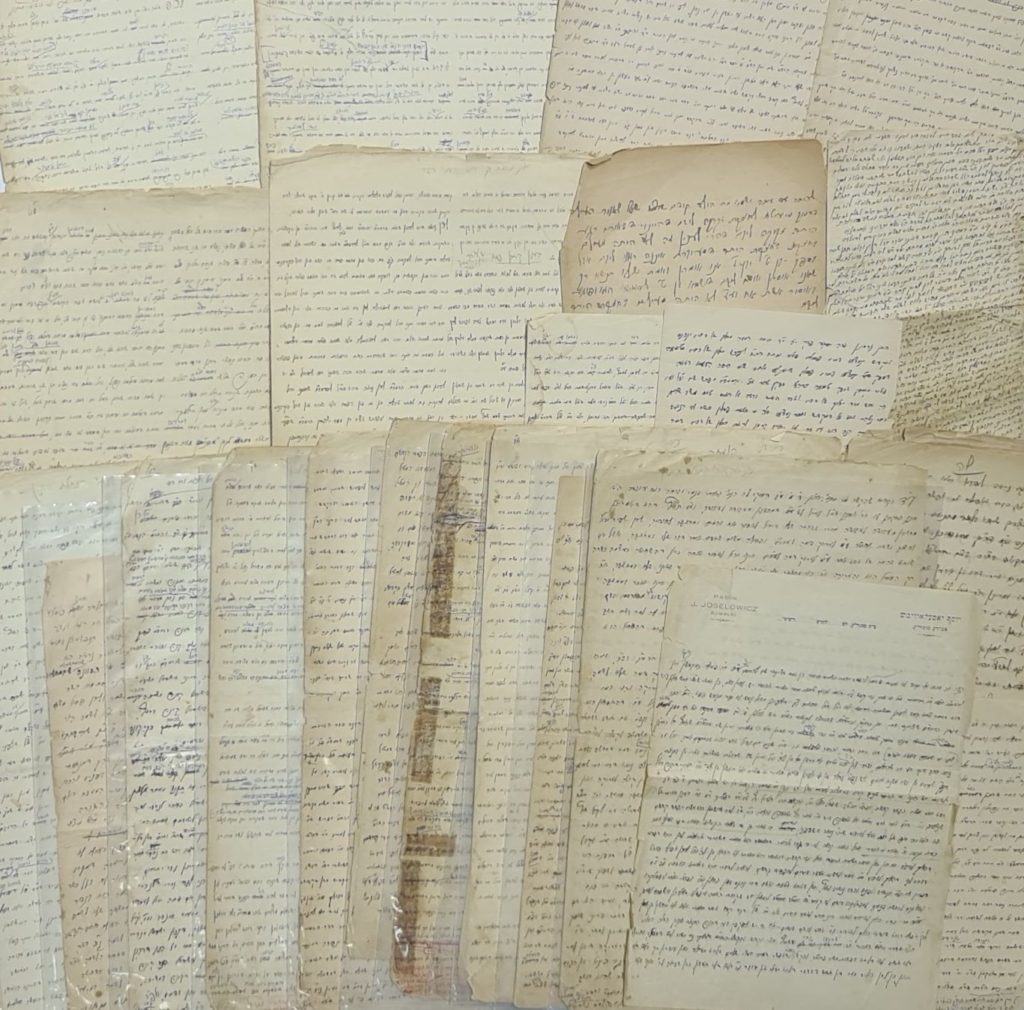
Large collection of novellae on various topics by Rabbi Yosef Yoselevitch, one of the geonim of Lithuania, known as rabbi of Suvalk. Approximately [100] pages written in his hand. Some of the novellae are on his stationery as rabbi of Suvalk.
His son-in-law Rabbi David Lipshutz published his letters in the book Minchat Yosef in two parts. Apparently, the novellae in this collection were not published in the book.
Refer to the Hebrew catalog text for a brief biography of Rabbi Yosef Yoselevitch .
Approximately [55] leaves, various sizes and conditions.
Overall fine condition.
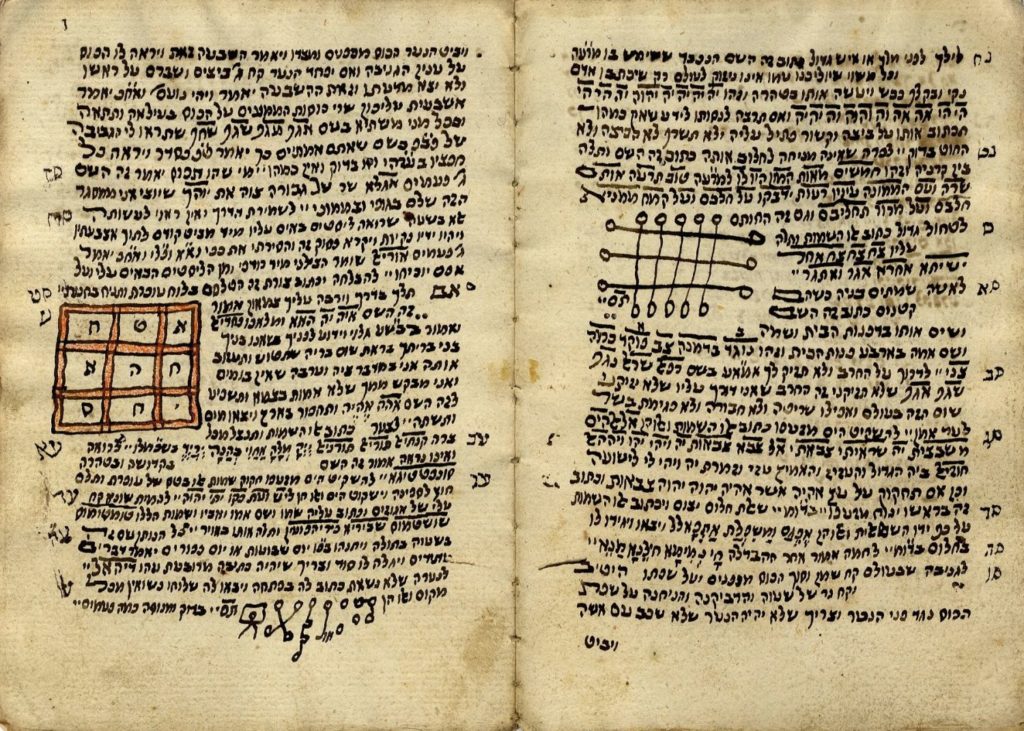
Notebook written by hand with many segulahs in practical kabbalah, and tales on the subject. Inter alia: Segulah for use on demons for people afraid of them; segulah for a ritual scribe for easy writing; for toothaches; for childless women; to know the gender of a fetus; for a bite by a rabid dog; to calm the raging sea; against people who cause damage; for love and more.
14 leaves, 16.5 cm.
Fine condition, aging stains, minimal ink smudges.
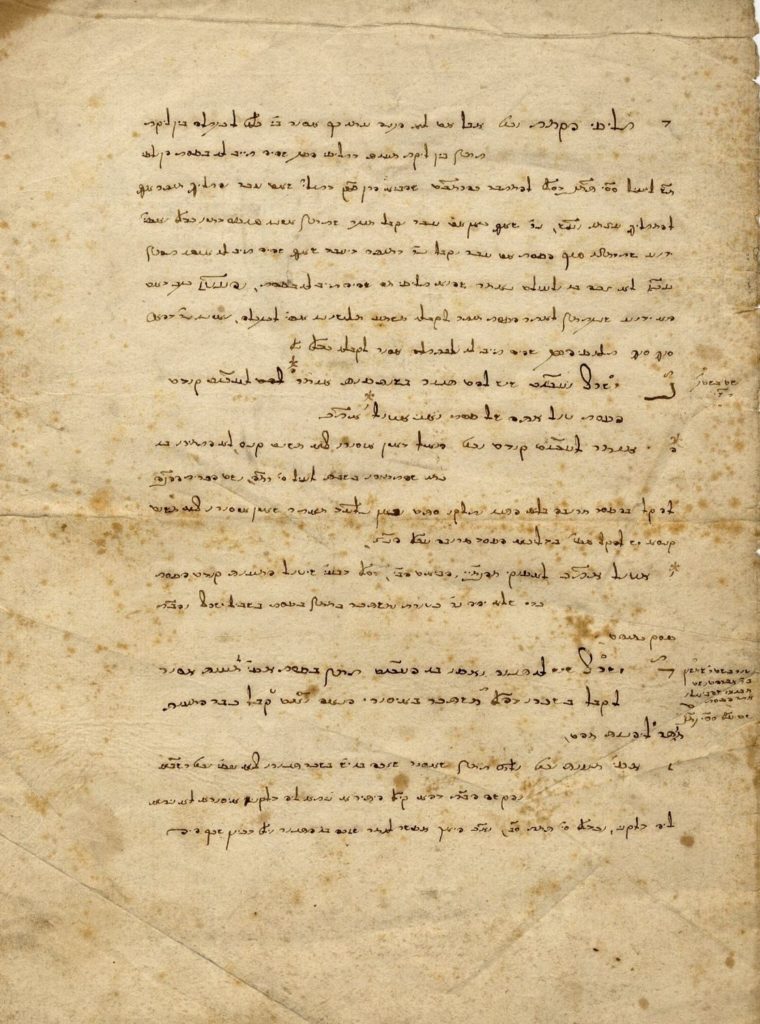
Large leaf consisting of compilations, novellae and halachic rulings on the halachahs of Passover, arranged in the order of Shulchan Aruch (siman 450).
Italian rabbinic script, apparently from c. 1700, possibly slightly earlier.
[1] leaf paper, 31×22 cm. Light, high-quality paper. Wide margins.
Fine condition: Aging and mold stains. Fold marks and creases. Slight tears in the margins, far from the text.
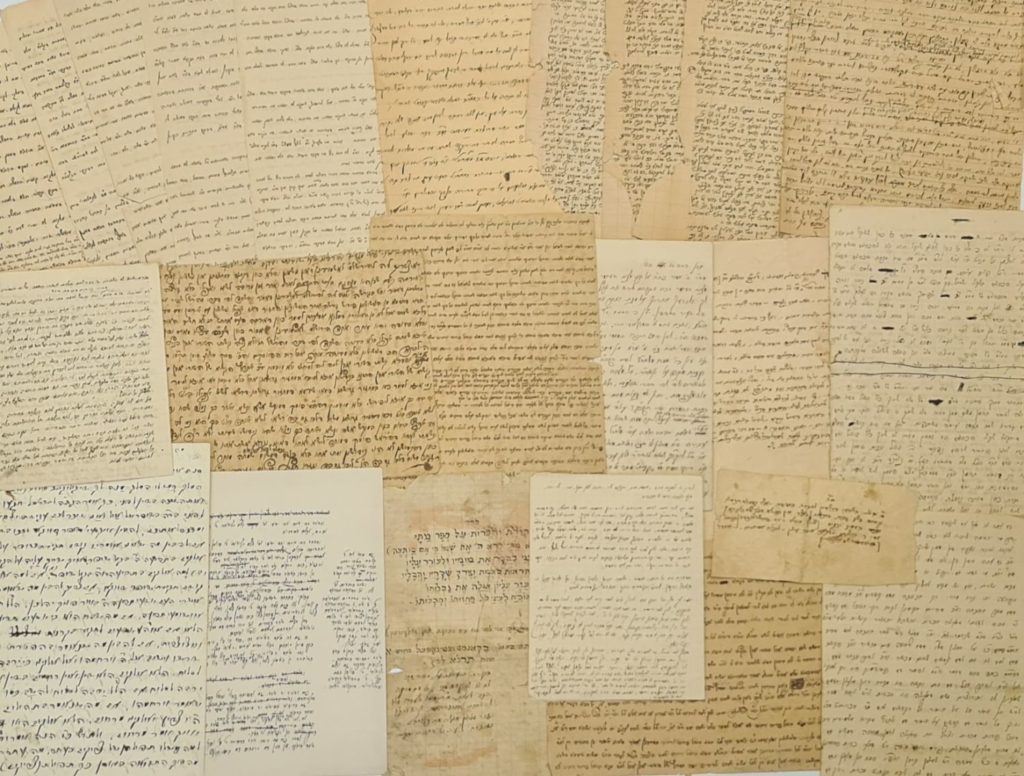
Group of leaves of Torah novellae from the 19th-20th Centuries. The content of the novellae and the identity of the writers have not been properly examined, and there may be discoveries.
One of the manuscripts is a copy of the Chatam Sofer’s sermons ( Drashot Chatam Sofer , Shavuot, 1801). Another manuscript is part of the book Derashot L’Kol HaShanah V’HaMoadim (Vilna, 1908) by Rabbi Yitzchak Nissenbaum. A third manuscript is a draft for the book HaYahadut V’HaDam (Russian, on the Beilis Affair) by Rabbi Avraham Chen of Novonivkov.
Approximately [30] leaves, entirely handwritten, various sizes and conditions. Overall fine condition.
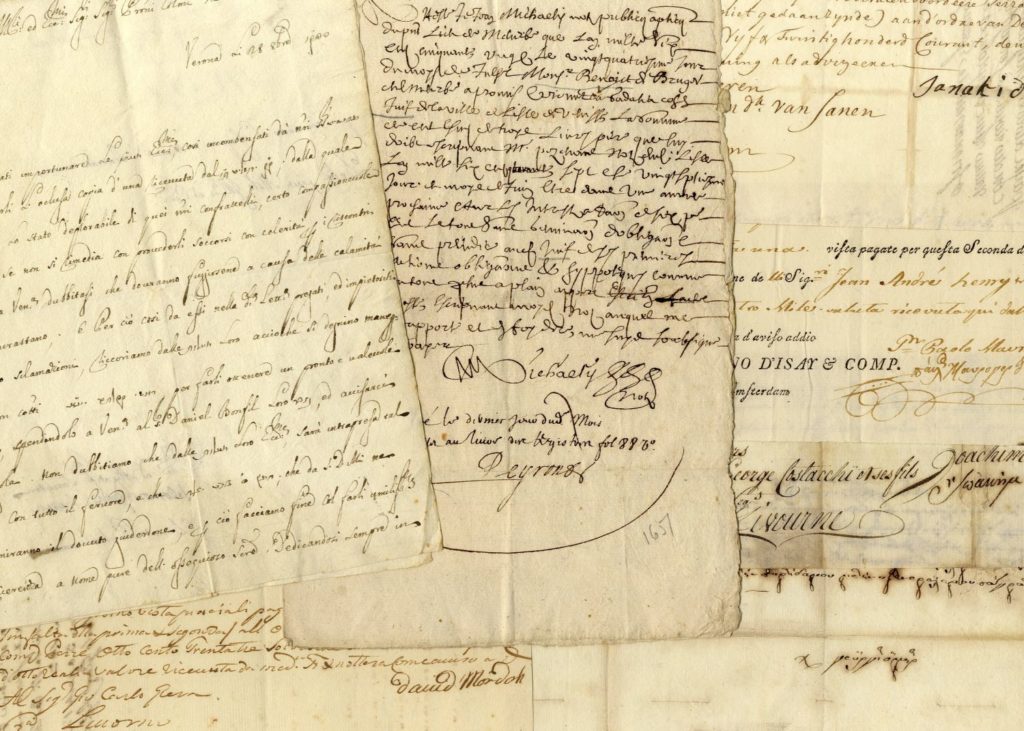
[16] antique Italian documents, most written in Italian, occasionally integrated with Hebrew words or signed in Hebrew.
The content of the documents has not been examined and there may be surprising discoveries.
Various sizes, overall fine condition.
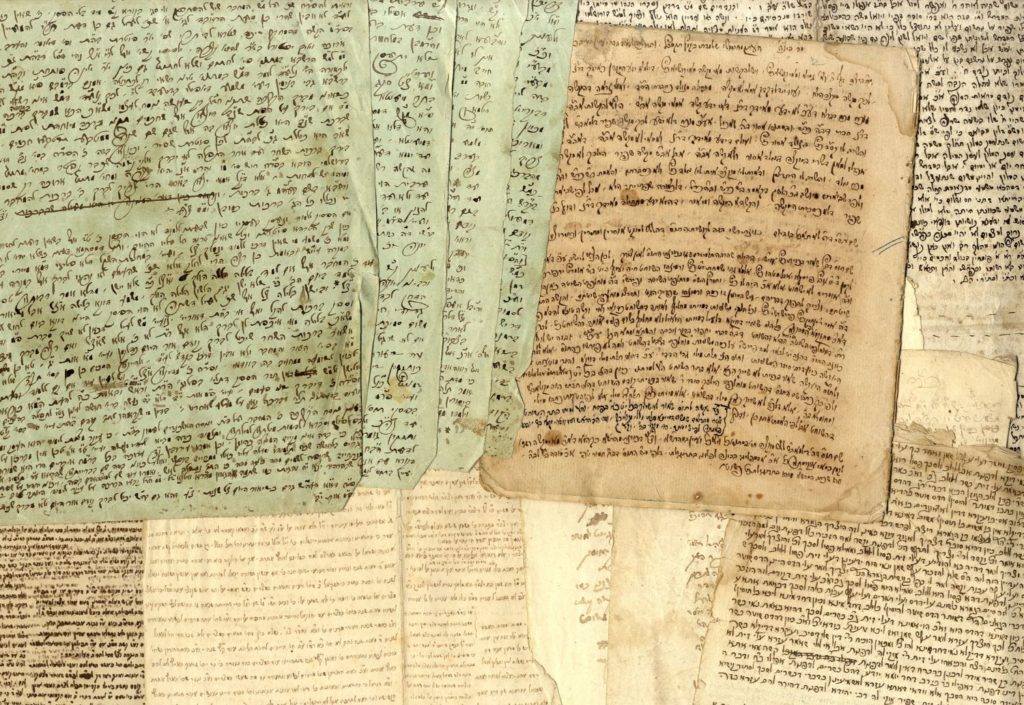
Group of various unidentified manuscripts, consisting of Talmudic novellae and sermons on aggadah that have not been thoroughly examined and may contain surprising discoveries.
* Novellae on Tractate Beitzah, “copy of my novellae from the summer of 1782.”
[16]-page booklet, of which [8] pages are written. 17-19 cm.
* Talmudic [גפ”ת] and halachic novellae from Tractate Berachot.
[8] written pages on greenish paper. 18×23 cm.
* In-depth elucidations on aggadah from our Sages.
[4] large pages, densely written. Approximately 34×36 cm.
* [5] leaves written on both sides.
Various sizes.
As mentioned, the material has not been properly examined. Overall fine condition.
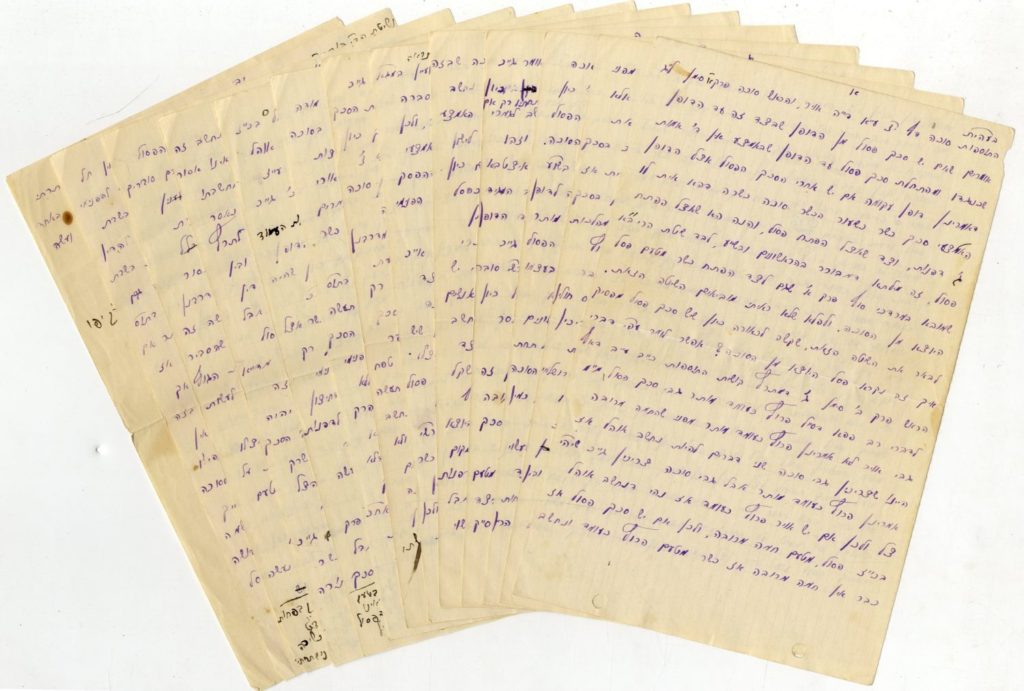
Kuntress Chiddushei Torah B’Masechet Sukkah Daf 7a. Entirely handwritten by the rosh yeshivah of Sha’ar Torah in Jaffa, Rabbi Yosef Rabi (Rabbi Kook’s brother-in-law). Jaffa, early 20th Century.
Upon Rabbi Kook’s arrival to serve as rabbi of the Jaffa community in 1904, the Sha’ar Torah yeshivah received serious forward momentum in its development. Rabbi Kook saw himself as patron and mashgiach of this institution, and he would pray at the local synagogue, test the students, and be involved in the curricula. As such, he published many letters calling for donors across the Jewish world to come to the assistance of the institution. The yeshivah was referred to by Rabbi Kook as “HaYeshivah HaMerkazit, ” but it was also called “Yeshivah L’Torah U’LeChochmat HaEmet” and “Yeshivat Sha’arei Torah” – and this name was used as well for the upper grades of the Talmud Torah. In various sources, it was called the non-specific name of “Yeshivat Mohara”i HaKohen Kook B’Yaffo.” In charge of the top class of the Talmud Torah (occasionally also called ‘the yeshivah’) was Rabbi Kook’s brother-in-law, Rabbi Yosef Rabi, who wrote these novellae.
[13] leaves, approximately 14×22 cm. Clear and orderly penmanship. The writer’s signature is in the margins of the letter.
Fine-very fine condition: Fold marks. Filing perforations. Minimal aging stains.
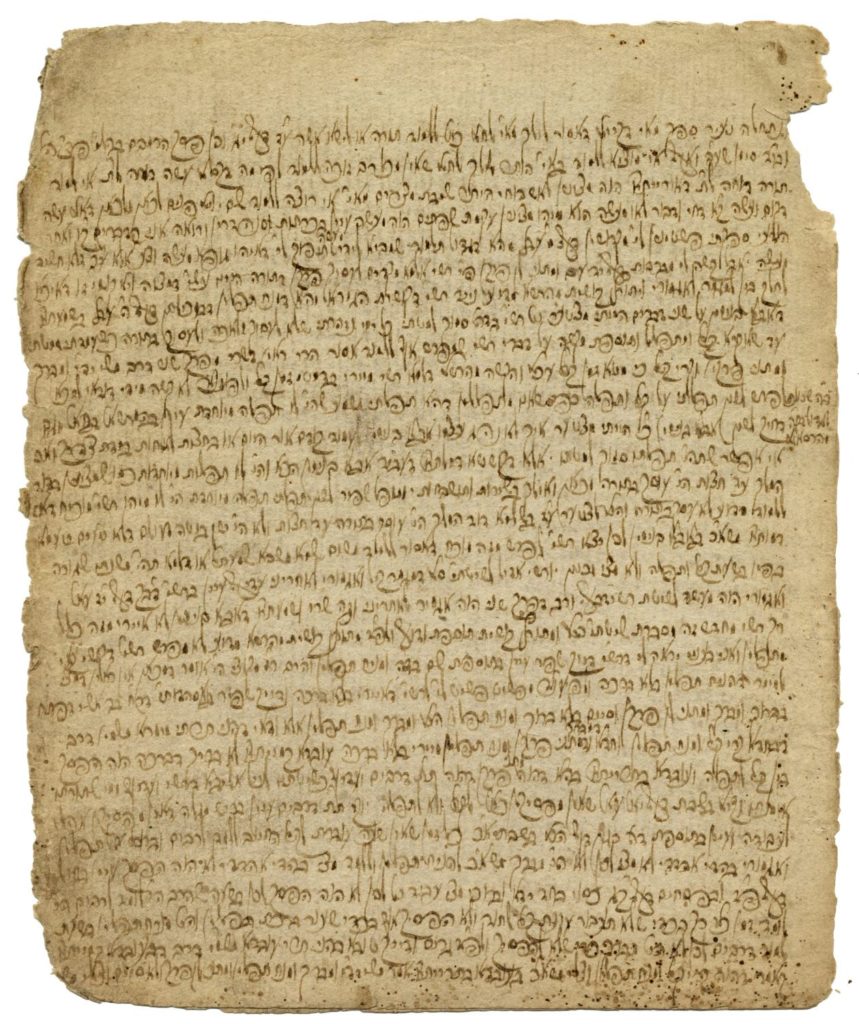
Complete sermon (missing the introduction) handwritten by Rabbi Meir Ashkenazi, Av Beit Din of Konstantin – son of Rabbi Yaakov Emden. Signed autograph.
Specifications: [4] pages. 17×20 cm. All in his hand and with his signature.
Unique Features: Crowded hand, signed with his usual signature: המאיר הקטן. Includes a lot of documentation and information regarding Rabbi Meir Ashkenazi, his relationship with the Baal Shem Tov and a copy of his handwriting.
Background: Rabbi Meir Ashkenazi was born in 1717, the oldest son of Rabbi Yaakov Emden, the “Yaavetz.” He began disseminating Torah throughout Poland at a young age. In 1750, he was appointed Av Beit Din in Konstantin, Wolyn. He served as rabbi in Konstantin for more than forty years, until he passed away at an old age in 1795. He was in contact with the Baal Shem Tov. Though at first he was opposed to chassidut, an episode occurred that drew him close to the Besh”t and he even hosted the Besh”t in his home in Konstantin. There is a story in the Shu”t Mayim Rabim by Rabbi Chaim HaKohen Rapaport, grandson of Rabbi Meir Ashkenazi, (Yoreh Deah, siman 27) about a rabbi who ruled that something was kosher in opposition to the words of the Rema. It includes a printed letter sent by the leaders of Mezibuzh, headed by the Besh”t, to Rabbi Meir Ashkenazi. They address him with many honorifics – and Rabbi Meir answered them in kind.
Condition: Moderate-fine. Light tears in the exterior margins, affecting solitary letters. This sermon was printed in Meor HaGadol [2009], section two.
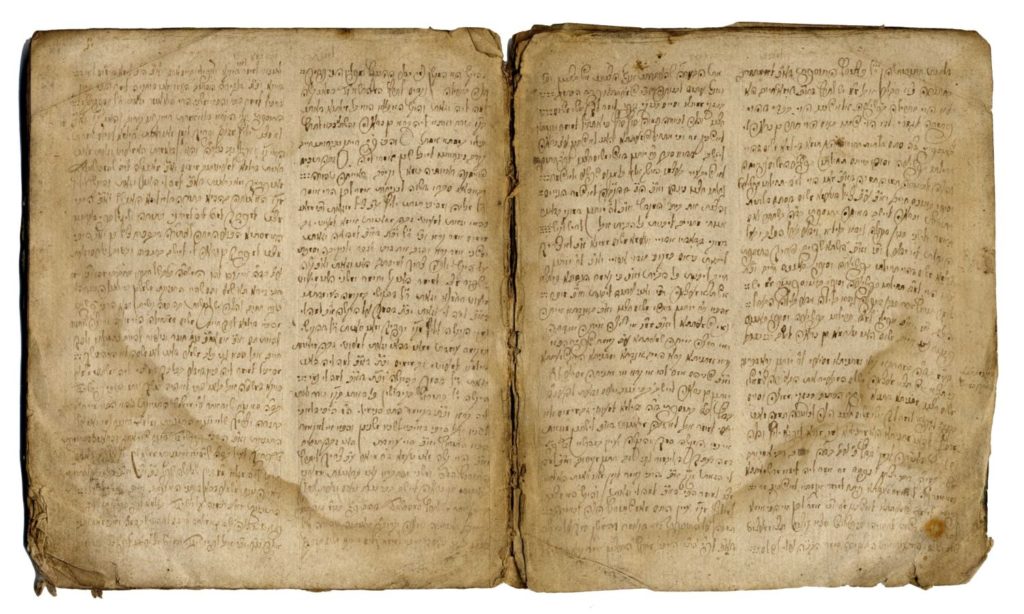
Handwritten work by a tremendous Torah scholar who is not identified, including novellae on the Talmud and Poskim.
Specifications: [33] leaves, Ashkenazi handwriting. Yet to be printed.
Content: Handwritten novellae on the tractates Baba Kama [pages 1-10 and 21], Baba Metzia [pages 11-12], Gittin [pages 12-13], Chulin [pages 13-15], Beitza [page 15 and 17, 32-33], Succah and Chagigah [page 16], Kiddushin [pages 17-18], Shabbat [pages 19-20] and Eiruvin [page 20]. Also a responsa on the laws of Choshen Mishpat [pages 21-28], Orach Chaim [pages 24, 27] and the laws of Pesach [pages 16-17, 29-32], Yoreh Deah [25], [Even HaEzer 25].
The author discusses the Rishonim at length, among the Achronim mentioned in the booklet are the Pnei Yehoshua, Ruach Chen and others.
Condition: Poor-moderate. The first leaf is detached from the spine, stains, wear on the edges of the leaves, some of the writing is faded and hard to read.
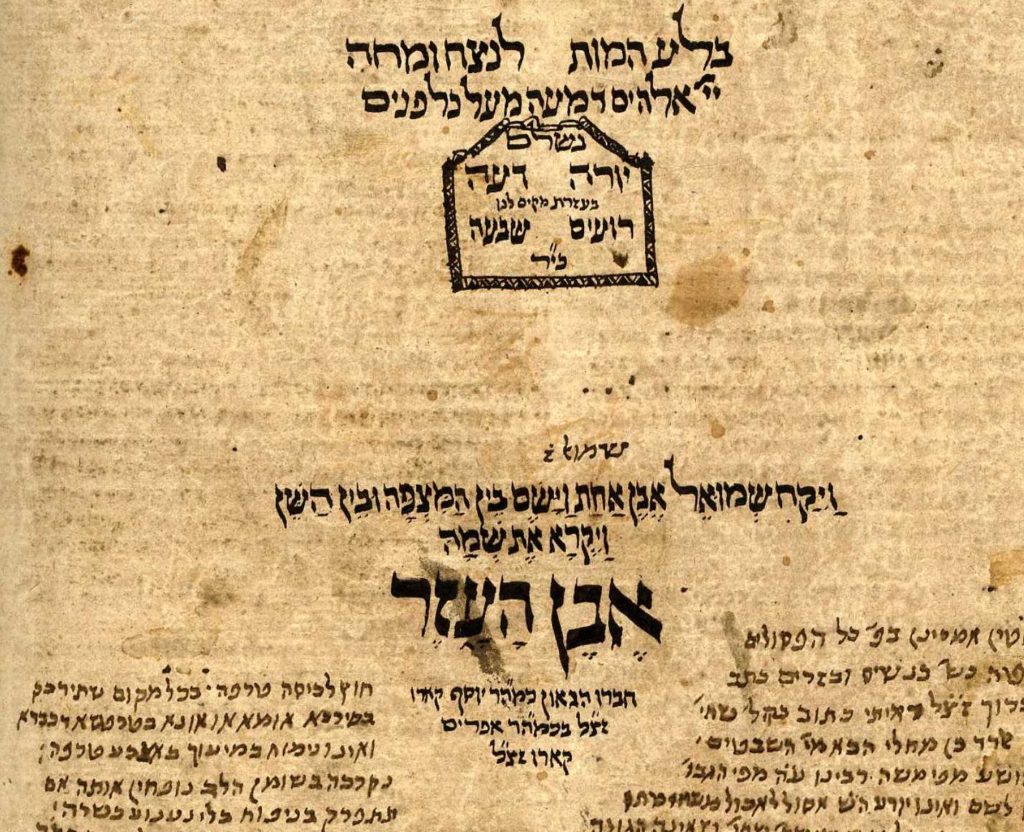
Shulchan Aruch by Rabbi Yosef Karo, four sections, copied by Meoded son of Saadya son of Yonah son of Gad Elchamati Elfatichi in Rada’a. Yemen, 18th of Tevet, 1695.
Specifications: [203] leaves, paper, 21×30 cm. Nice, Yemenite script.
Nice handwritten copy of the entire Shulchan Aruch according to the first edition printed in Venice, in 1565-1566. Without the “Haghaot HaRama,” which was not accepted in Yemen. Handwritten text in two columns, titles of the simanim in large letters and with titles at the top of the page. The writer even copied the author’s introduction. At the start of each section, the copier wrote a quasi-title page in large letters and with a corresponding verse, and at the end of Yoreh Deah there is a nice, small sketch.
Unique features: This is a complete, early handwritten copy of the Shulchan Aruch and is very rare – particularly with a detailed colophon.
Condition: Fine. No worming holes! Aging stains. A number of leaves are loose. The title page and the first and last leaves are detached with tears, primarily in the blank margins with blemishes to solitary words. Original, chafed leather binding.
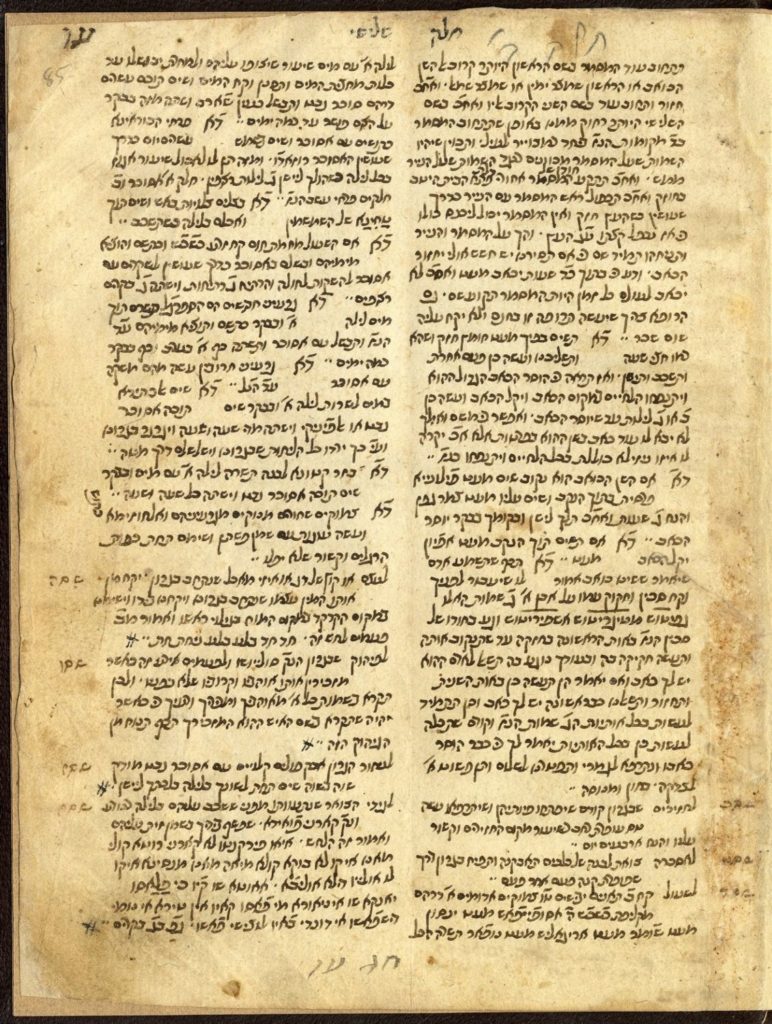
Segulot and remedies in the handwriting of Rabbi Chaim Vital. Oriental script. 1500s.
Specifications: [2] pages, a leaf with writing on both sides. Two columns per page, approx. 40 lines per column. 20×15 cm. Entirely in his own handwriting.
Unique Features: Leaf from Rabbi Chaim Vital’s important manuscript, Sefer HaRefuot VeHaSegulot VeHaPeulot . On this leaf, Rabbi Chaim Vital wrote various segulot and remedies, with the asseveration that they were related by trustworthy teachers who tested and proved their effectiveness. Rabbi Chaim Vital added “Proven” to one of the segulot enumerated on the page before us.
Contents: Among the segulot written are:
* Segula for coughing
* Segula for a fish bone or spur, or other food item of any sort that is caught in the throat
* Segula for night waking [Here Rabbi Chaim added “Proven.”]
* Segula for tenderizing the meat of an old chicken
Background: Rabbi Chaim Vital [1542-1620] was the Arizal’s greatest student, and the one who transmitted his teachings to future generations. It is known that the Arizal prohibited his students from recording his words, except for Rabbi Chaim Vital, since he alone knew how to fathom their depths. The Arizal also expressed that his entire purpose for coming to the world was to teach Rabbi Chaim kabbalah.
Expert’s certificate attached, stating that Rabbi Chaim Vital’s handwriting is known and recognized, and that the handwriting on the leaves before us is identical to his well-known writings.
Condition: Fine. Aging stains. Placed in a magnificent leather binding.
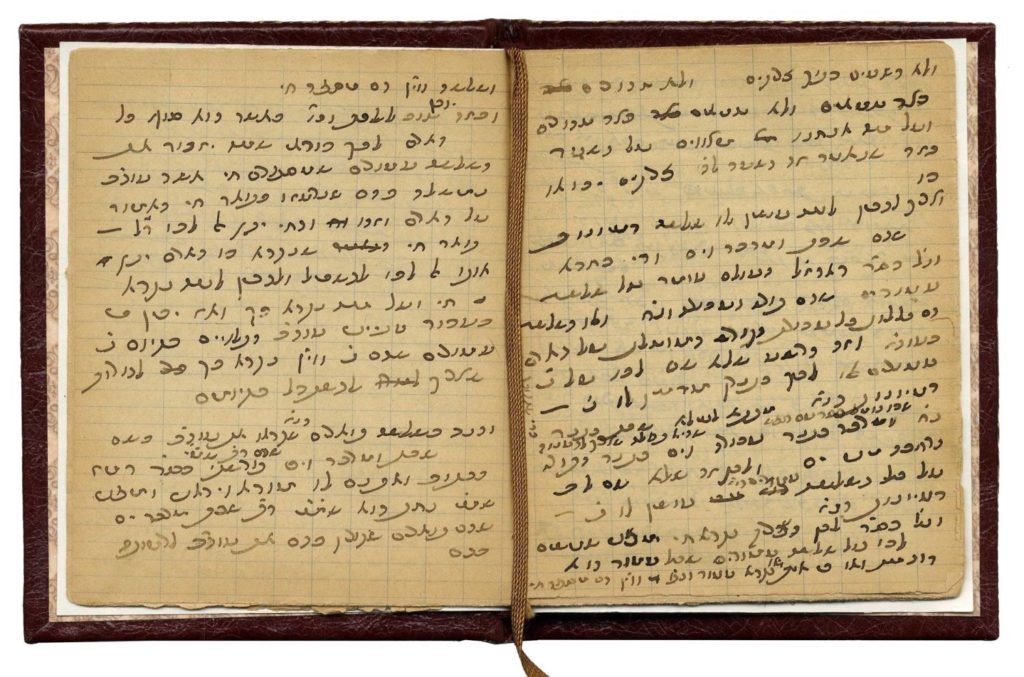
Handwritten s ermon by Rabbeinu Yosef Chaim of Baghdad, the “Ben Ish Chai,” a eulogy and discussion of the great merit of shedding tears over the passing of a righteous person. [1897]
Specifications: [37] pages, paper. 10×13 cm. Typical Sephardic hand with deletions and corrections. About 18-22 lines on each page.
Content: Eulogy for Chacham Yitzchak Mordechai Sasson, prominent Iraqi Sage, Rosh Metivta of Beit Zilkha and head of “Yeshivat Chacham Yitzchak.” He was known as the rabbi of Rabbi Shimon Agassi, Rabbi Yechezkel Ezra Ilya, Rabbi David Sofer, Rabbi Yechezkel Ezra HaLevi, and many other prominent Iraqi Torah scholars.
Unique features: The eulogy was printed in Shnei Eliyahu – Niveh Tzadikim [drush 5]. However, this manuscript has about another eight pages that were not printed in the book [!]. In these leaves, the Ben Ish Chai offers a lengthy elucidation of the verse in Ecclesiastes, “Better to go to a house of mourning than a house of celebration.” In addition, the book does not mention the name of the subject of the eulogy, while Rabbi Yosef Chaim notes the name of the deceased in this manuscript and the precise date the eulogy was delivered.
Background: Rabbi Yosef Chaim of Baghdad (1833-1909), author of the Ben Ish Chai , was the most prominent Oriental sage of his time. His father was Rabbi Eliyahu Chaim son of Rabbi Moshe Chaim, rabbi of Baghdad. He was a disciple of Rabbi Abdallah Somekh, and his genius and righteousness were apparent from a young age. He started sermonizing in the great Synagogue when he was only 26-years-old. He continued delivering these sermons every Shabbat and holiday for about fifty years! Thousands of people gathered to listen to his eloquent words for four to five hours. He was world-renowned as “once-in-a-generation” in his knowledge of the hidden and revealed Torah and was noted for his great sanctity. In 1879, he traveled to the Land of Israel to pray at the graves of the righteous people, when it was Divinely revealed to him that his soul was rooted in that of Benyahu ben Yehoyada. He titled many of his dozens of works according to this name: Ben Ish Chai, Ben Ish Chayil, Ben Yehoyada, Rav Pe’alim, Od Yosef Chai and more.
Condition: Very fine. New, magnificent leather binding. Minimal stains.
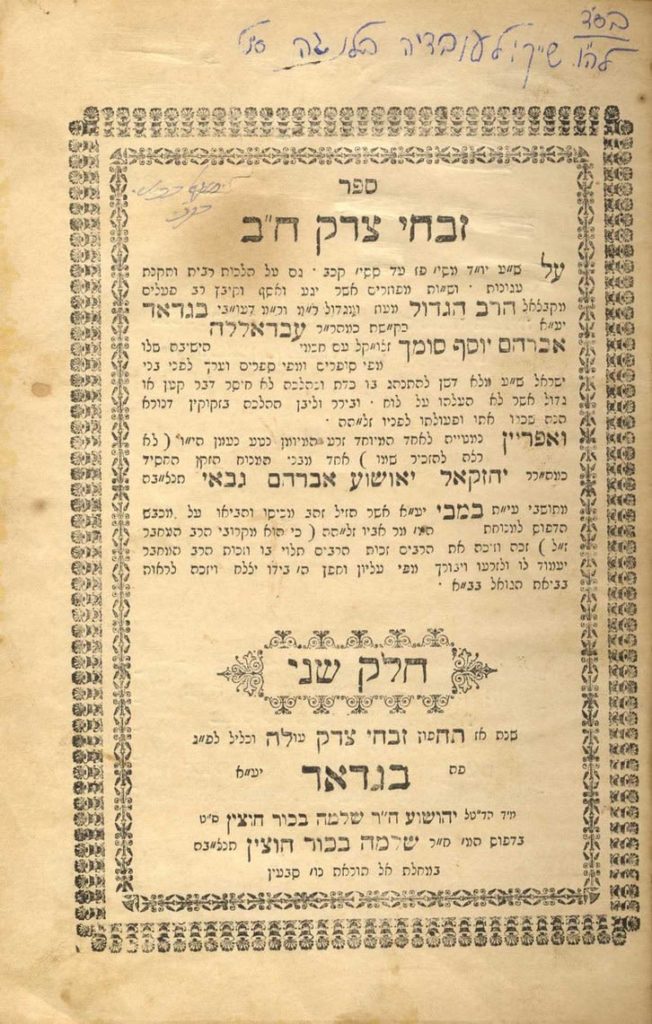
Significant historic and bibliographic discovery. Zivchei Tzedek with an owner notation on the title page: יחזקאל כחלי (Yechezkel Kachli), in the hand of Rabbeinu Yosef Chaim of Baghdad.
Background: In 1973, the book Shu”t Torah LiShma was printed with 524 responsa. The book was written in the hand of Rabbi Yosef Chaim of Baghdad, and each responsa was signed, “the young Yechezkel Kachli.” In the manuscript, Rabbi Yosef Chaim wrote “so the copier says” that the manuscript miraculously reached him in an antiquated hand that was difficult to read, and he copied it. He mentions Rabbi Yechezkel Kachli who started writing the work in 1682. The book was published by his grandson, Rabbi David son of Yaakov ben Rabbeinu Yosef Chaim. The book opens with the story of the manuscript. It states that Rabbi Ben Tzion Chazan z”l related that Rabbi Avraham Ades saw that in his Rav Pealim, Rabbeinu Yosef Chaim mentions the T orah LiShma by Rabbi Yechezkel HaKachli, who sent a number of questions to Baghdad to Rabbeinu Yosef Chaim, including some about the Torah LiShma. He received answers to all of his questions, other than the question about the work Torah Lishma . He writes that it became apparent to Rabbi Avraham Ades that Torah LiShma was authored by Rabbeinu Yosef Chaim, who, for unknown reasons, didn’t want to reveal that he wrote it. He also writes that “Yechezkel Kachli” has the same gematria value as “Yosef Chaim.” The author chose to hide his name, since there are those who believe that there are reasons for an author to hide his name.
Since then, a number of editions of the book have been printed. In 2013, an edition was printed by “Ahavat Shalom” with an introduction by Rabbi Yaakov Moshe Hillel, in which he includes strong, clear proofs that the author was indeed Rabbeinu Yosef Chaim and even brings kabbalistic reasons why the author chose this specific name. Rabbi Yaakov Chaim Sofer brings a number of proofs in a few of his works that the author was the author of Ben Ish Chai .
On the other hand, there were those who challenged this attribution, and believed that this work was copied from an early manuscript, as the Ben Ish Chai wrote. Over the years, many leading Torah scholars learned this work and a number of its responsa. Some believed that the responsa contained opinions that could not possibly have been written by the Ben Ish Chai, and some even found contradictions to the Rav Pealim . As a result, there were those who disagreed with a number of the halachic rulings and wrote that it is unclear whether or not the Ben Ish Chai wrote the work. Others maintained that the Ben Ish Chai wrote the book in his youth, and therefore, the responsa do not always align with what he wrote in other locations. Rabbi Ovadya Yosef quotes this work dozens of times, however he never definitively writes that the author was the Ben Ish Chai. Rabbi Shalom Messas wrote that it doesn’t seem that the author was the Ben Ish Chai. Rabbi Shalom Cohen wrote: We must check the issue to its source, it is possible that the issue requires intensive clarification and a decision by a sage.
Unique features: This book sheds lights on the polemic regarding the identity of the author of Shu”t Torah LiShma and confirms the opinion of those who believe that it was the Ben Ish Chai. The form of the letters of the signature clearly indicate that it was written by the Ben Ish Chai, and proves that the Ben Ish Chai also signed his name “Yechezkel Kachli” [יחזקאל כחלי] and that he himself used this nickname. Leaf 3 bears an additional signature that was crossed out.
Condition: Fine. This lot includes a report written by an expert confirming that this signature was written by Rabbeinu Yosef Chaim of Iraq, author of Ben Ish Chai . This signature can finally clarify a polemic that has stretched out over dozens of years. A lot of material about this subject is included.
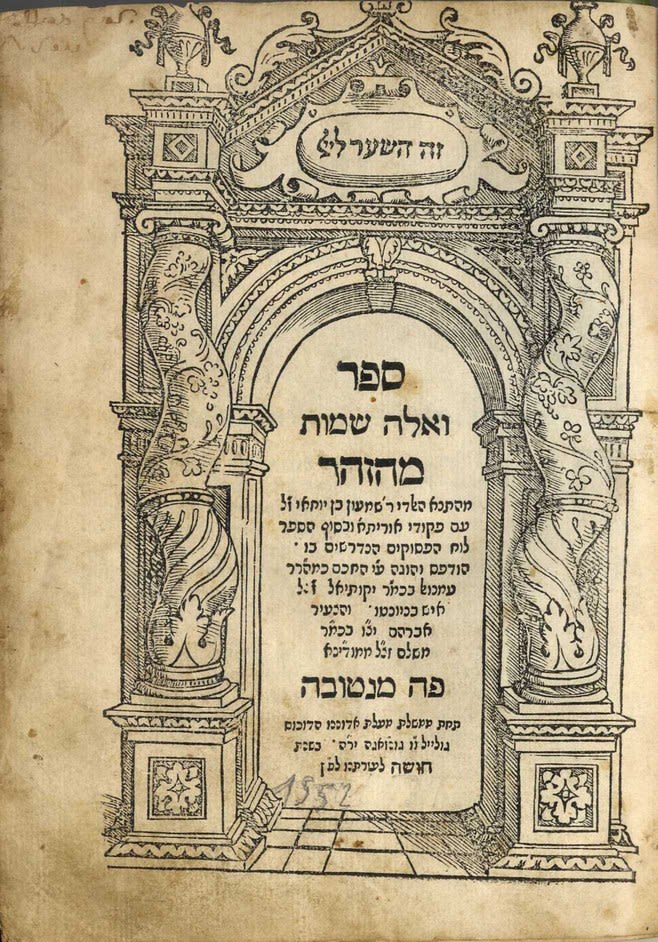
Zohar on Shemot. Mantua, [1559]. First edition. Unknown work in the margins of the book’s sheets, Ashkenazic handwriting, beginning of the 17th century.
Specifications: 269 pages, 25 cm.
Backgound: First edition of the Zohar ever printed. Almost one hundred years had passed since the advent of Hebrew book printing, and the Zohar had not yet been printed. The book of the Zohar was brought to the printing press only after the halachic rulings permitting printing the Zohar , which contains the Torah’s sodot (deep spiritual matters).
Unique Features: Approximately five hundred and fifty handwritten pieces of commentary and explanation of the Zohar ‘s words appear on the margins of the sheets. The commentary is actually a short, concise explanation of the Zohar ‘s words in a clear and fluent language. Most of the pieces start with the words, ‘Here, he reveals the sod to you …’ or, ‘You will find a sod here’ or, ‘See a sod here.’ To the best of our knowledge, this work has not been published.
From the style of the author’s writing, it it clearly the work of a great kabbalist to whom the paths of the secrets of kabbalah are clear and revealed to him. Many times, he writes, “and the educated will understand,” or comments such as, “Look and see they are all great sodot, unless your eyes are (no more than) flesh” (26b). Apparently, the sole work mentioned in his words is the previous book on kabbalah, Shaarei Orah (for example, see leaf 96a: “refer to Shaarei Orah gate 5, and this sod will be revealed to you”).
On the flyleaf at the end of the book, a copy of ‘[Reply from a] sage who wrote his knowledge of sefirot and atzilot to his student.’
Most of the manuscript was written by one writer, but there are glosses and references in an Italian writing, possibly one of the Nortzi family’s, who are mentioned further on. In the margins of leaf 114a, ‘תמה אני המעתיק איך רב ייבא סבא וכו’ is written.
Owner’s signature: “Yitzchak Mehallalel Nortzi” on the book’s title page, on the upper right corner. The Nortzi family was a family of philanthropists and great rabbis in Mantua, apparently he is the father of Rabbi Moshe Netanel Nortzi, who was an adjudicator in the RaMaZ’s beit din. It’s possible that some of the glosses are his. Two of the glosses end with the name signed “Hirsch” or “Hertz” (26b, 67a).
Condition: Fine. A few worming holes in the margins of the leaves. Aging stains. Magnificent leather binding.
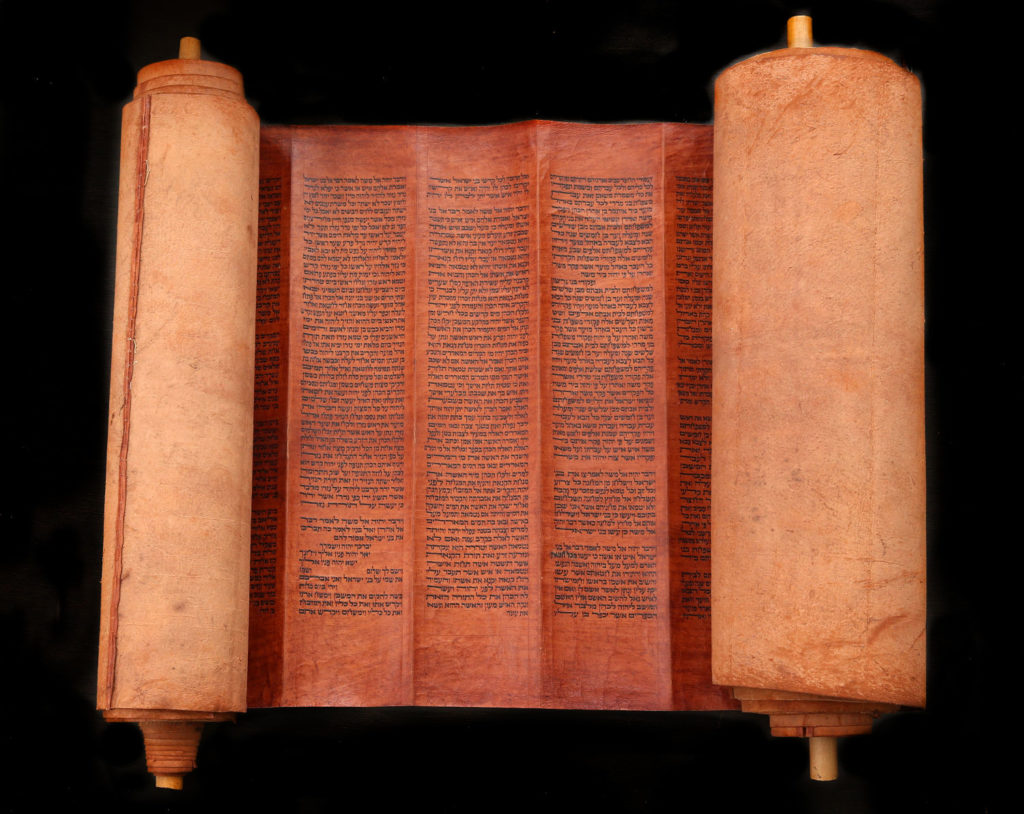
Complete Torah scroll. Apparently written in the late 18th century. Some of the sheets (יריעות) have been replaced with later ones. 51 lines per column. Written on 50 sheets sewn together. Approximately 231 columns. Parchment width: 47 cm. The scroll is not “tagged” as was customary in the period in which it was written. There are circular pressure marks for the etnachtah (אתנחתא) and sof passuk (סוף פסוק) cantillation marks to ease reading. Overall fine condition. Some of the stitches are loose. Minimal repairs in the body of the parchment. The kashrut of the writing has not been examined.
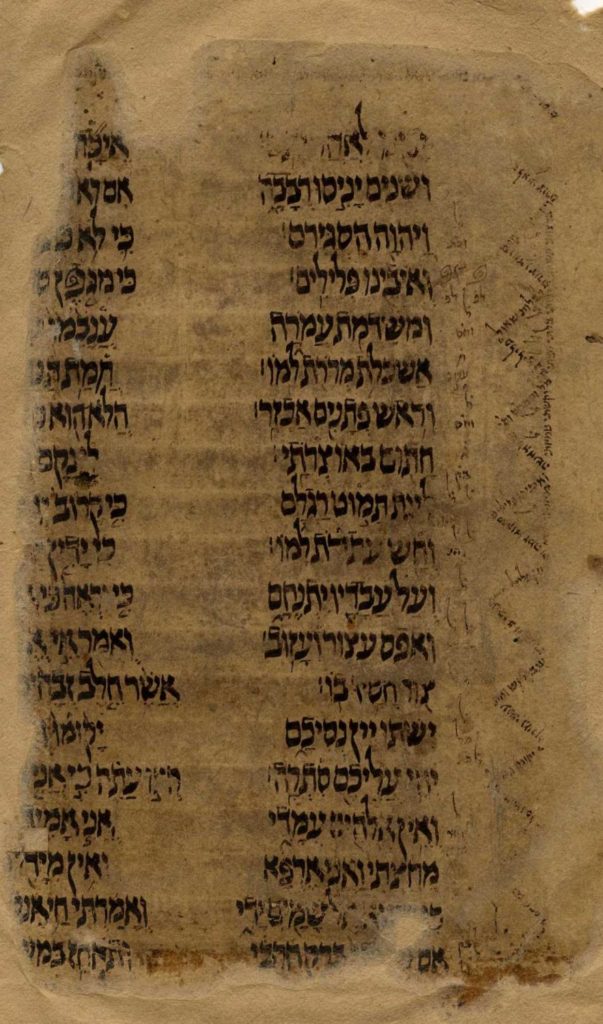
Leaf from “Shirat Haazinu” from an ancient chumash that was apparently copied by the famed Yemenite scribe, Benaiah HaSofer. Comparison of this manuscript with another work copied by Benaiah on the Torah (Manuscript London Or. 2348), clearly indicates that the letter shapes and the rare quality of ink is almost identical. In some of his manuscripts, such as this leaf before us, he wrote the “mesorah hagedolah” and “haketanah” with graphic embellishments that suit the text written on the leaf. Very rare.
Benaiah son of Saadiah son of Zachariah son of Benaiah son of Oded son of Marga from Sana’a was one of the most prestigious copiers in Yemen – if not the most prestigious. He copied dozens of manuscripts in Yemen from 1460-1483 (according to the colophon dates). He passed away in 1484, per a letter copied by his son Yosef that year. He was the patriarch of the Benaiah family, a family of artist-scribes active in Sana’a in the late 15th century- early 16th century. His family members were renowned for their expertise regarding the “mesorah” and designating the text. The Hebrew Palaeography Project features about 40 of their manuscripts, including location and year they were copied, masterpieces from private collections and libraries throughout the world. (Refer to: Michael Rigler’s article, “Benaiah HaSofer V’Tze’etza’av; Mishpachat Sofrim MiTeiman”, Peamim – Quarterly Journal for the study of Jewish Communities in the Orient , [64, 1995], p. 54-67.)
[1] thick paper. 17×27 cm. Block Yemenite script. With vowelization and mesorah. Moderate condition. Cropped margins. Professional restoration.
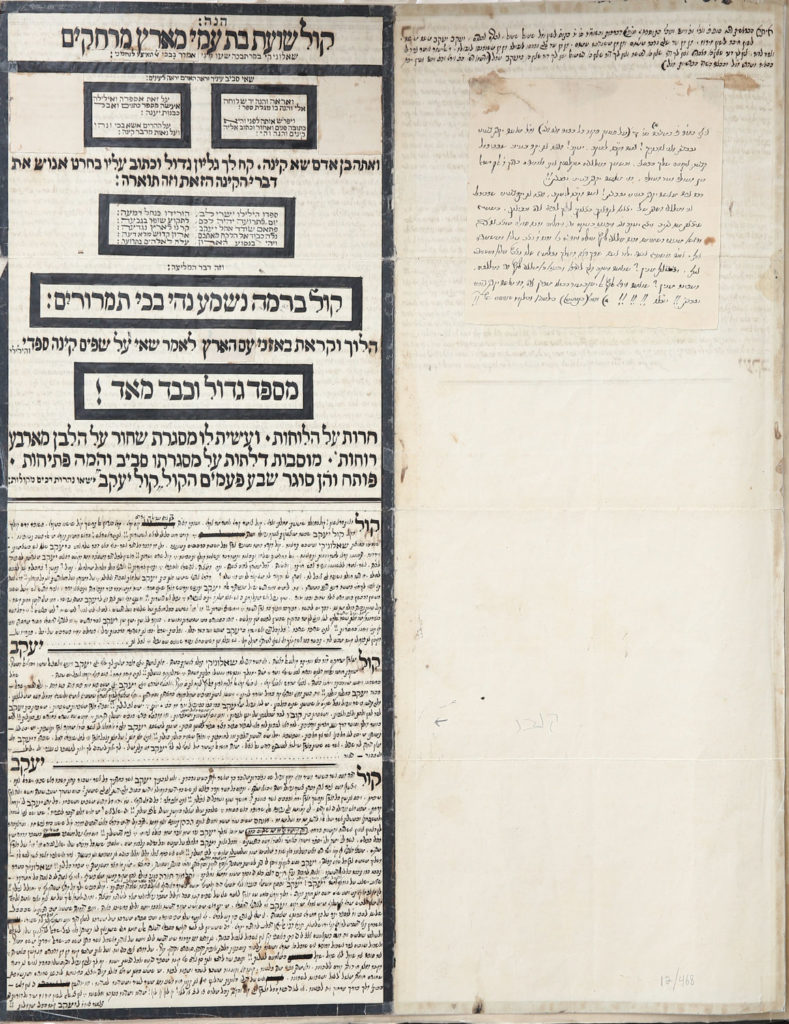
The elegy is comprised of seven stanzas, each starting with the word ‘קול’ and concluding with the word ‘יעקב.’ The identity of the writer is unknown. The body of the elegy hints to his given name, Menachem.
The gaon Rabbi Chanania Kubo, author of Shu”t Kochav Yaakov, was rabbi of Salonika from 1888 until his passing in 1907. He was a blood relative and son-in-law of the great rabbi Rabbi Rephael Asher Kubo, Av Beit Din of Salonika, author of Shu”t Shaar Asher . Rabbi Yaakov established the Beit Yosef yeshivah and the Etz Chaim institutions in Salonika and was very active on behalf of residents of the city. His name was glorified by Salonika residents not only as a Torah genius, but also as a merciful and compassionate father to all Jews of Salonika.
The degree of admiration in which he was held can be comprehended from this lengthy elegy full of words of praise and glory about his righteousness and activities.
There is a short elegy added at the end about the passing of the Rishon LeTziyon, Rabbi Yaakov Shaul Elyashar, the “Yisah Berachah.”
[1] large leaf paper with a black border signifying mourning. 48×60 cm. Written on both sides. Oriental script. Fine condition. Aging stains. Placed in a designated cloth binding.
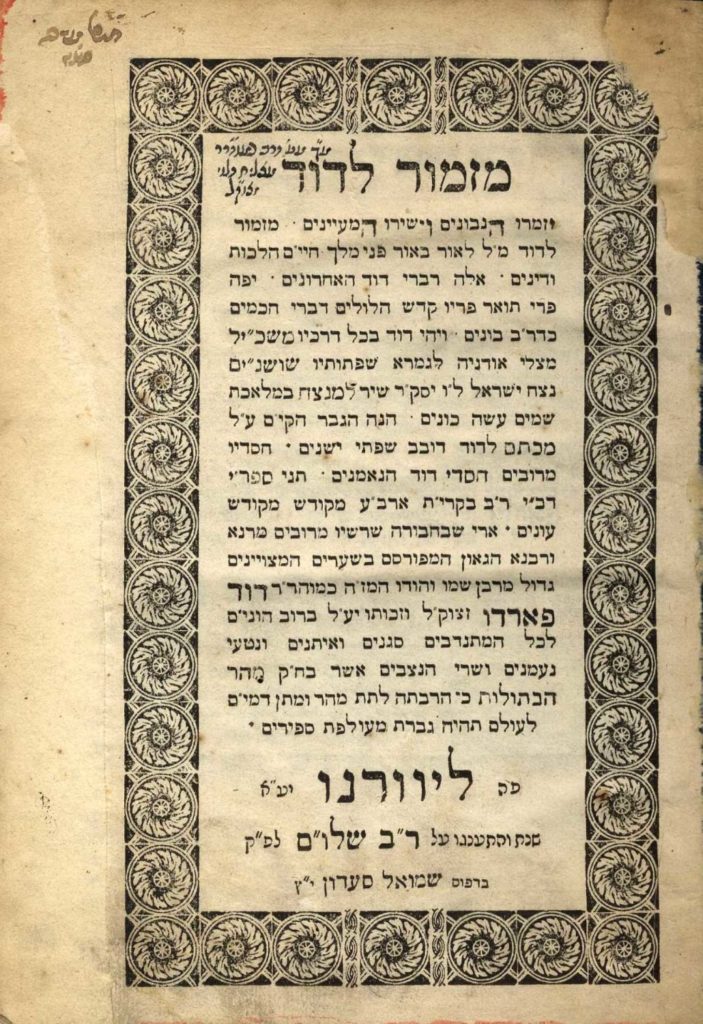
* Mizmor L’David . [1818]
* Mikraei Kodesh . Venice, [1586].
* She’elot V’Teshuvot by Rabbi Moshe di Trani. Section one. Venice, 1629.
* Mareh HaGadol . Salonica, [1829].
* Cheshek Shlomo . Salonica, [1600].
* Tzur Yaakov . Izmir, [1886].
For details, refer to the Hebrew catalog text.
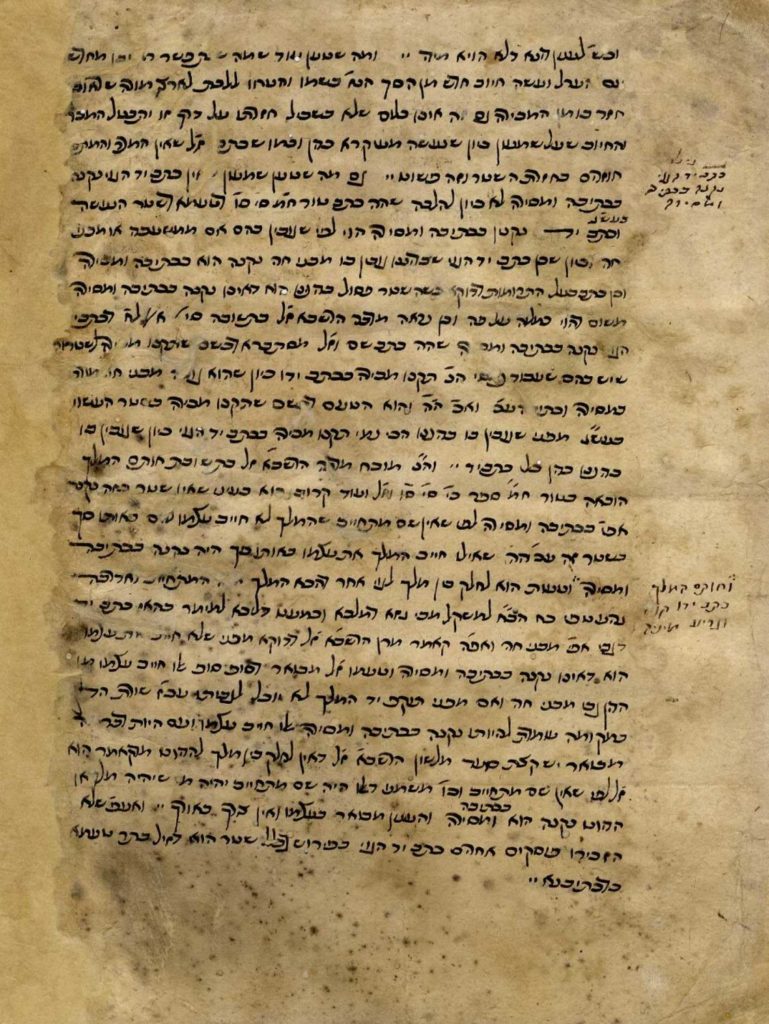
Halachic responsum by Yaakov de Castro. Manuscript prepared for print and then proofread by the author, the Maharik”sh. 3 marginal glosses in the hand of the Maharik”sh. These glosses were inserted in the printed responsum in his Shu”t Ohalei Yaakov , siman 2.
Rabbi Yaakov de Castro (1525-1612) was one of the prominent Later Authorities during the times of the Beit Yosef. He was a disciple of Rabbi Levi ben Chaviv (the Maharlba”ch) and Rabbi David ben Zimra (Radba”z). He served as rabbi of Egypt and headed the yeshivah there. In 1570, he was honorably hosted in the home of Rabbi Yosef Karo in Safed. His works include Erech Lechem – glosses on the Shulchan Aruch; Shu”t Ohalei Yaakov – which was printed in Leghorn in 1783, about two hundred years after his passing. His novellae on Tractate Beitzah titled Toldot Yaakov were printed in Jerusalem, in 1865. His novellae on Tractate Bava Kama were recently printed from manuscript by the Ahavat Shalom yeshivah.
[1] leaf, 21×13 cm. Scribal writing on both sides of the leaf, the glosses of the Maharik”sh are on the second page. Fine condition. Professionally restored. Aging stains, minimal blemish to letters, the text is entirely legible.
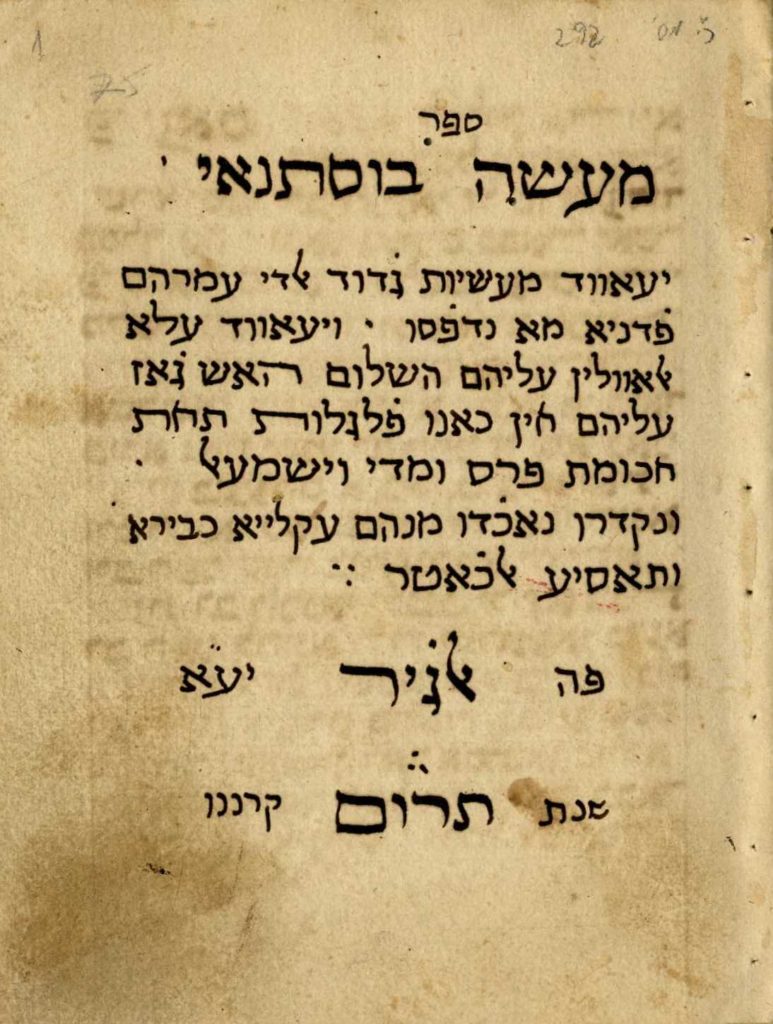
Excerpt from Sefer Ma’ase Bustenai by Meir Lehmann, in Judeo-Arabic. Copied from the print, “Here in Algeria in the year ת’ר’ו’ם’ קרננו”
Copy of several stories from a very rare series of booklets published in Algeria regarding Jewish history. “Under the government of Persia, Media and Ishmael.”
6 leaves (with text only on the back page of each leaf). Ink on very thick paper. After 1886. 12×15.5 cm. Block letters in Judeo-Arabic. Very fine condition. Aging stains. Cardboard binding.
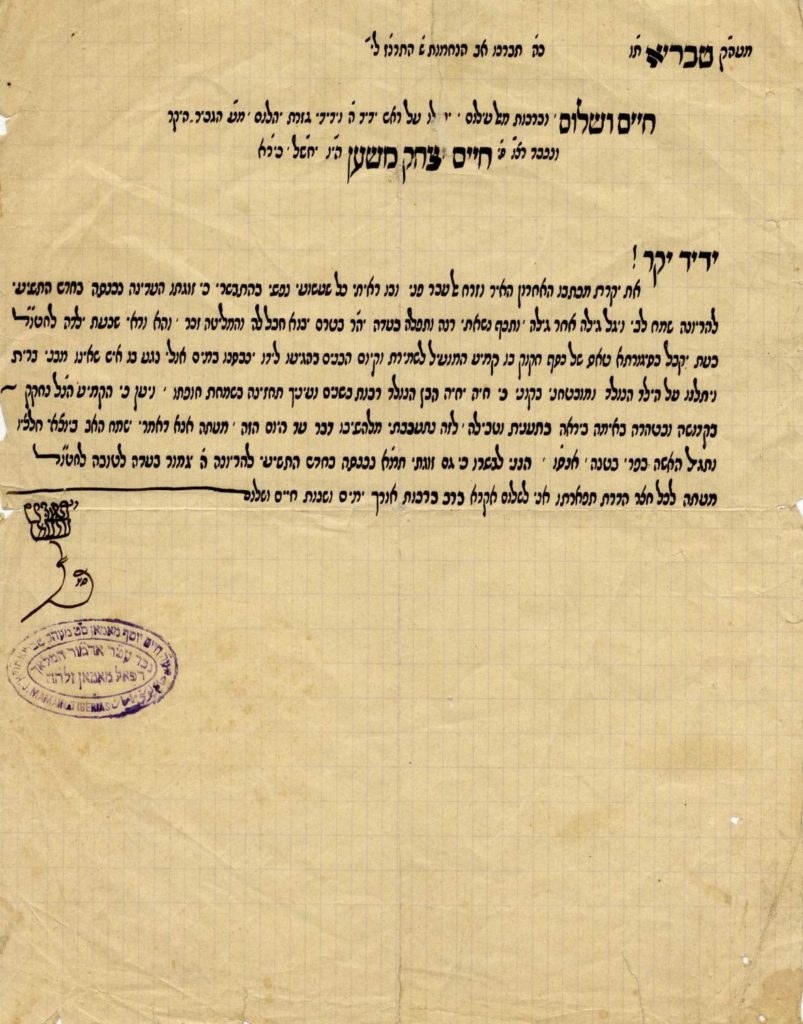
Greetings to a donor who supports Torah and its scholars, Chaim Yeshua Mishan, in which he informs the receiver that he sent him an amulet for an easy birth: ” … which was written in sanctity and purity with awe, fasting and ritual immersion …”
Rabbi Chaim Yosef Maman was born in Meknes – a grandson of Rabbi Refael Maman, known as “Refael HaMalach” (“the angel Refael”). He served as rabbi in Tiberias and in Oran and Témouchent, Algeria. He was involved in the polemic about flour ground at a cylindrical mill for Passover use, regarding concerns mentioned in Peter Rechem.
[1] leaf paper. 27×21 cm. Sephardic hand. Fine condition. Light tears without loss.
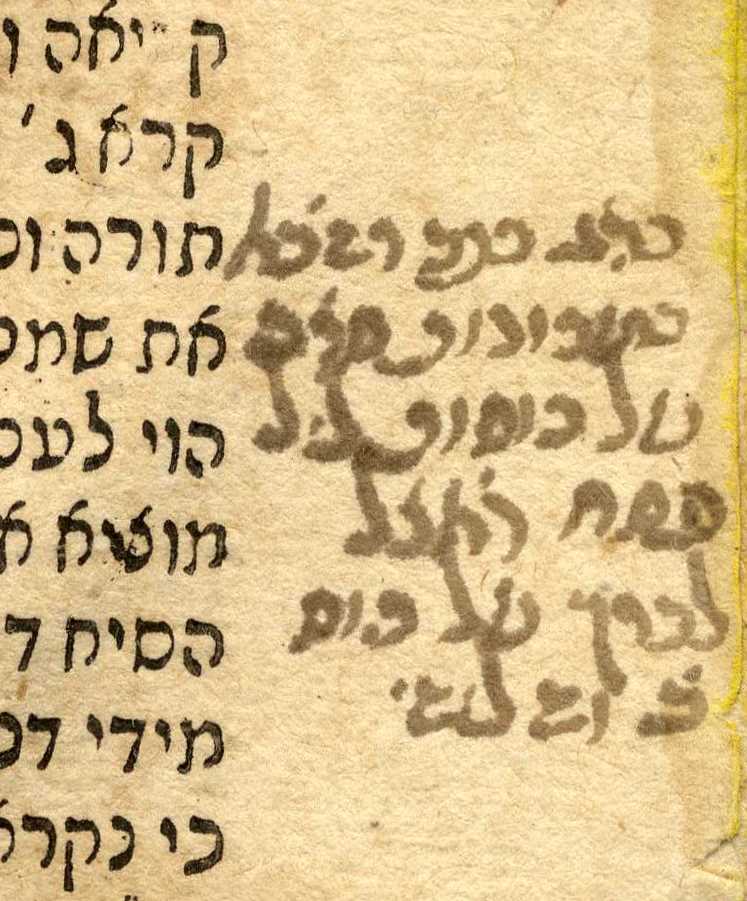
Pri Chadash, halachic novellae on the Shulchan Aruch Orach Chaim, by Rabbi David di Silva. Copy used by Libyan rabbis with their signatures and glosses:
Leaf 1, Rabbi Shaul Adadi’s signature.
Leaf 38, gloss with note by Rabbi Avraham Kalfon. Throughout the book there are glosses (in a thick pen) by Rabbi Avraham Adadi. Throughout the book there are many glosses (in tiny writing) in the hand of Rabbi Shaul Adadi. With stamps stating that the book belonged to Rabbi Avraham Adadi.
Rabbi Avraham Kalfon [c. 1735-1820] was a prominent Tripoli rabbi and leader. He authored works and hymns, and is known for his work Chayei Avraham . He admired the Chid”a and corresponded with him. He traveled from Tripoli to Leghorn to spend time with the Chid”a, and stayed there for a year and a half. He recorded the Chid”a’s customs and conduct that he had seen. He also authored the Maaseh Tzadikim and Leket HaKatzir.
Rabbi Avraham Chaim Adadi – Av Beit Din of Tripoli, was a grandson of Rabbi Massoud Chai Rokeach, author of Maaseh Rokeach . He started serving as an adjudicator at a young age, and traveled to Safed, Egypt, Persia and Damascus. He passed away in Safed in 1874. He authored HaShomer Emet, Vayikra Avraham . Rabbi Avraham dedicated his home to the community. One room was used as a synagogue and another as a library – the largest in Tripoli. It was used as a study hall for sages who learned there. This book was used in that room and was stamped by his son: [in Hebrew] “From the library of the yeshivah of my father, Rabbi Avraham Chaim Adadi ztzuk”l, the youth Shaul Adadi.”
Rabbi Shaul [Ovadya] Adadi was the son of Rabbi Avraham Adadi, Av Beit Din of Tripoli. He took over his father’s position when he moved to Safed. He edited and published his father’s work, Vayikra Avraham .
The endpaper mentions Rabbi Chaim Rabbah, who was an adjudicator together with Rabbi Avraham Adadi (refer to: Arzei HaLevanon , p. 704). The book is of exceptional importance in regards to the history of Libyan rabbis. Moderate condition. Missing title page. Aging stains. Tears.
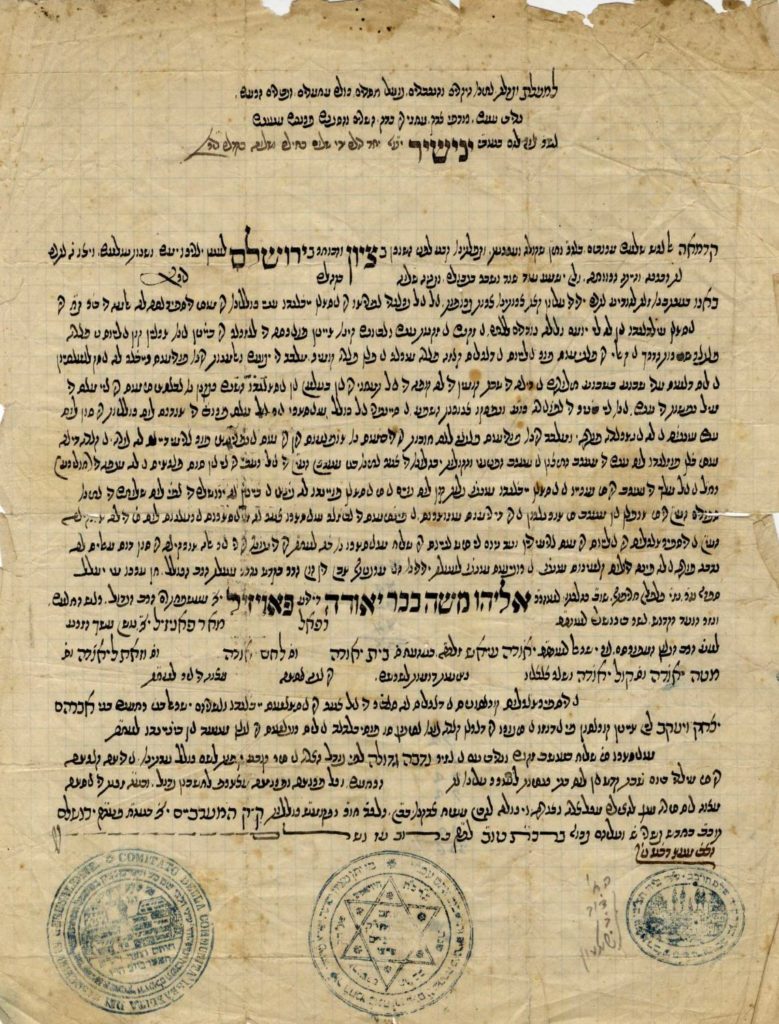
Writ for Rabbi Eliyahu Moshe Becher Yehudah Panigel, emissary for the ‘K”K HaMaarvim’ [Maghreb community] in Jerusalem, sent to the Yenisehir congregation in Turkey. Ladino, “In the month of Tishrei … 1878.” With the stamps of the institutions of the Maghreb community in Jerusalem.
Rabbi Eliyahu Moshe Panigel [1850-1919] was an adjudicator in the Jerusalem beit din, a poet and a liturgical composer. He was one of the most famous preachers in the city. His oratorical skills convinced the Jerusalem rabbis to appoint him an emissary. He traveled to many countries including Tunisia, Algeria, Libya, Morocco, Italy, India and Bukhara, and was active on behalf of many Jerusalem institutions. Due to the difficult sanitary conditions and spread of disease in the city, the Misgav Ladach organization was established, and Rabbi Eliyahu Moshe was the chairman of its board. In 1907, he was appointed Rishon L’Tziyon for a period of time, but he resigned about two years later to prevent a disagreement. He remained involved in communal activities and even received General Allenby upon the latter’s arrival in Jerusalem.
[1] leaf. Ink on paper. 16×23 cm. Sephardic-Oriental hand. Fine condition. Light tears without loss.
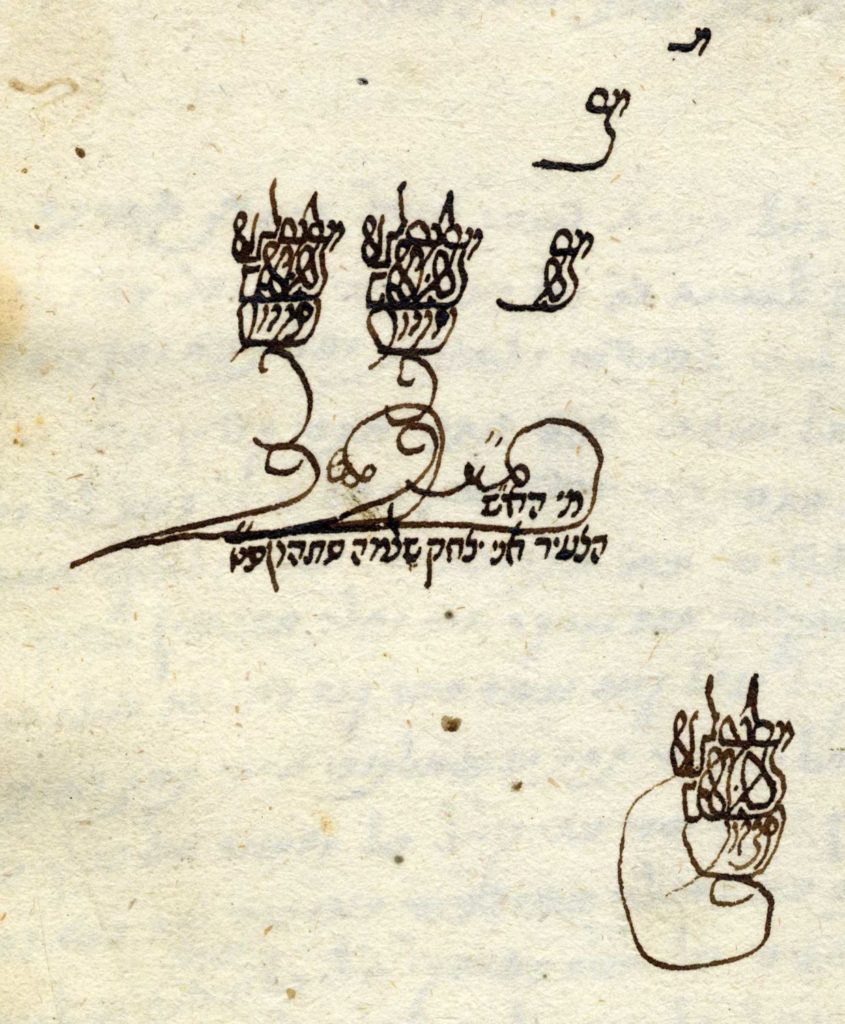
Sermons on the weekly Torah readings and various subjects, compilations, notes and poems in the hand of Rabbi Yitzchak Shlomo Sathon of Tiberias.
Rabbi Yitzchak Shlomo signed his name a number of times in the manuscript (the signature was compared to a copy of his signature in the Sefer Teveriah , p. 307), and a few times he calls himself בר”ת אי”ש צעיר. Three leaves in a different hand, headed with the date 1836, were not written by him.
Rabbi Yitzchak Shlomo was an erudite Torah scholar, who worked as a Sofer Stam and sold books to earn a living, since he did not want to support himself directly through his Torah studies. He passed away in Tiberias in 1931. His epitaph states that he was a “… rabbi and righteous person, pious and humble, diligent in Torah, straight and loyal, beloved by the Heavens and amongst people.” He left behind other manuscripts that are in the Ben Zvi Institute in Jerusalem.
[128] leaves (about 40 are blank). 20×14 cm. Thick paper, Oriental hand. Very fine condition. Beautiful new binding.